BUICK REGAL 2001 Owners Manual
Manufacturer: BUICK, Model Year: 2001, Model line: REGAL, Model: BUICK REGAL 2001Pages: 365, PDF Size: 2.97 MB
Page 241 of 365
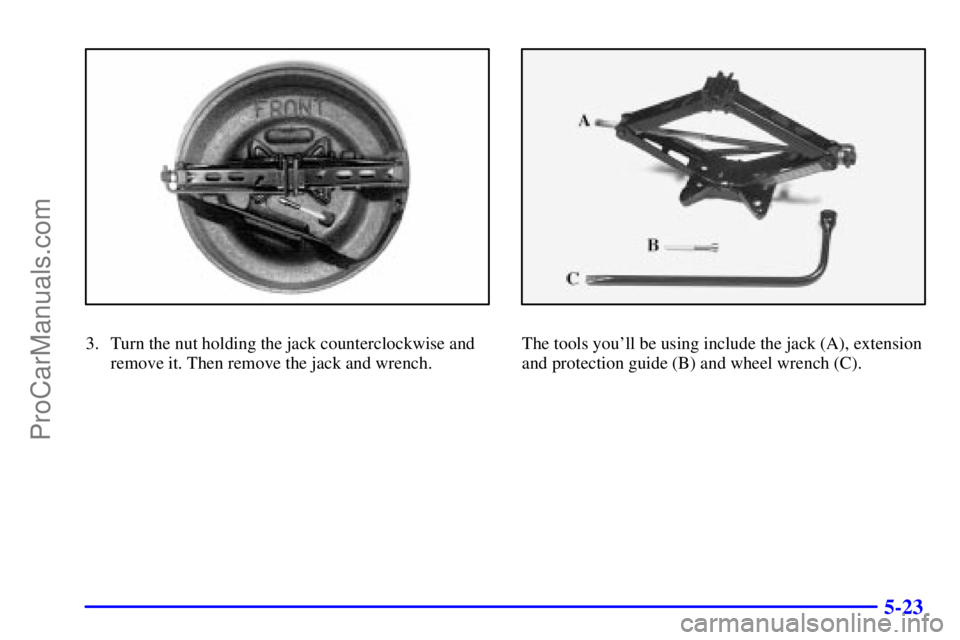
5-23
3. Turn the nut holding the jack counterclockwise and
remove it. Then remove the jack and wrench.The tools you'll be using include the jack (A), extension
and protection guide (B) and wheel wrench (C).
ProCarManuals.com
Page 242 of 365
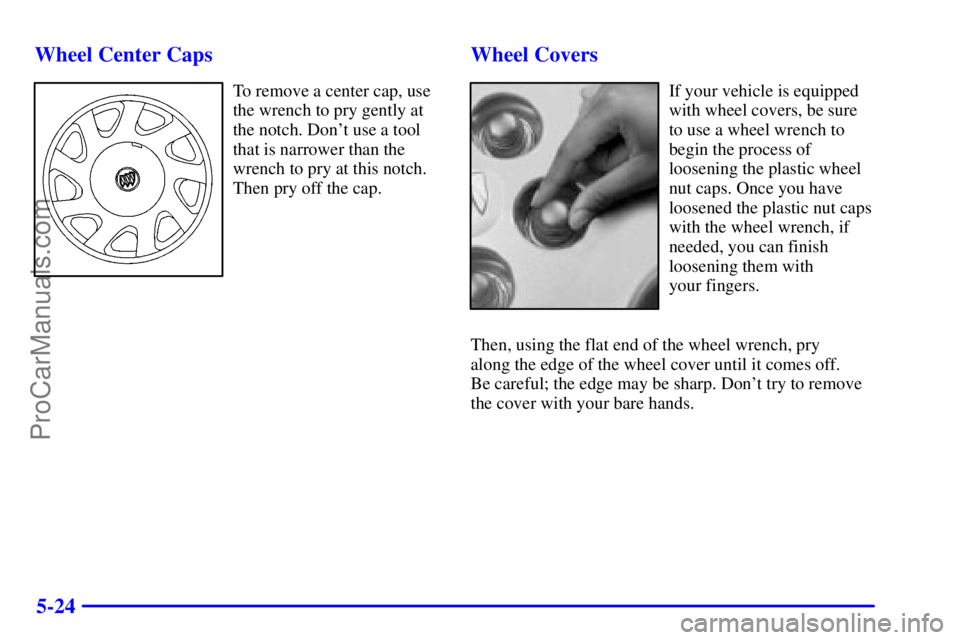
5-24 Wheel Center Caps
To remove a center cap, use
the wrench to pry gently at
the notch. Don't use a tool
that is narrower than the
wrench to pry at this notch.
Then pry off the cap.
Wheel Covers
If your vehicle is equipped
with wheel covers, be sure
to use a wheel wrench to
begin the process of
loosening the plastic wheel
nut caps. Once you have
loosened the plastic nut caps
with the wheel wrench, if
needed, you can finish
loosening them with
your fingers.
Then, using the flat end of the wheel wrench, pry
along the edge of the wheel cover until it comes off.
Be careful; the edge may be sharp. Don't try to remove
the cover with your bare hands.
ProCarManuals.com
Page 243 of 365
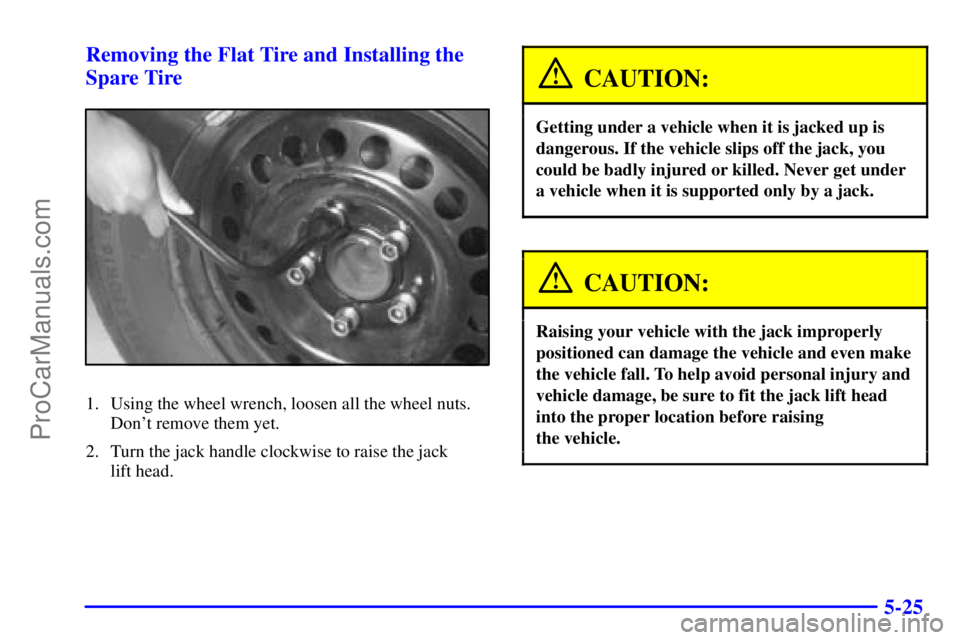
5-25 Removing the Flat Tire and Installing the
Spare Tire
1. Using the wheel wrench, loosen all the wheel nuts.
Don't remove them yet.
2. Turn the jack handle clockwise to raise the jack
lift head.
CAUTION:
Getting under a vehicle when it is jacked up is
dangerous. If the vehicle slips off the jack, you
could be badly injured or killed. Never get under
a vehicle when it is supported only by a jack.
CAUTION:
Raising your vehicle with the jack improperly
positioned can damage the vehicle and even make
the vehicle fall. To help avoid personal injury and
vehicle damage, be sure to fit the jack lift head
into the proper location before raising
the vehicle.
ProCarManuals.com
Page 244 of 365

5-26
3. For jacking at the vehicle's front location, put the
jack lift head (C) about 6 inches (15 cm) from the
rear edge of the front wheel opening (B) or just
behind the two bolts (A) as shown.For jacking at the vehicle's rear location, put the jack
lift head (B) about 5 inches (13 cm) from the front
edge of the rear wheel opening (C) or just behind the
off
-set (A) as shown.
4. Put the compact spare tire near you.
ProCarManuals.com
Page 245 of 365
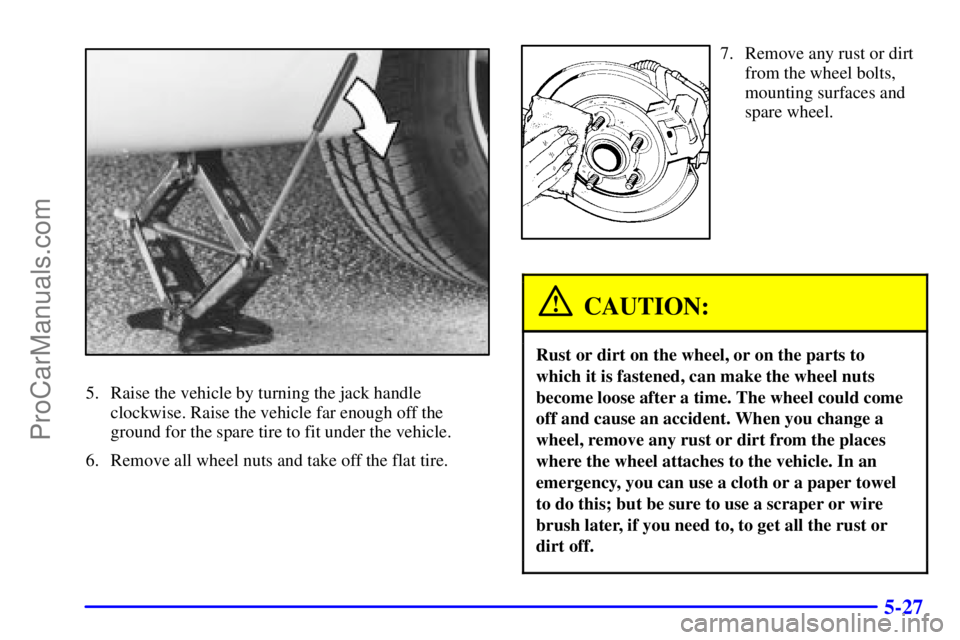
5-27
5. Raise the vehicle by turning the jack handle
clockwise. Raise the vehicle far enough off the
ground for the spare tire to fit under the vehicle.
6. Remove all wheel nuts and take off the flat tire.
7. Remove any rust or dirt
from the wheel bolts,
mounting surfaces and
spare wheel.
CAUTION:
Rust or dirt on the wheel, or on the parts to
which it is fastened, can make the wheel nuts
become loose after a time. The wheel could come
off and cause an accident. When you change a
wheel, remove any rust or dirt from the places
where the wheel attaches to the vehicle. In an
emergency, you can use a cloth or a paper towel
to do this; but be sure to use a scraper or wire
brush later, if you need to, to get all the rust or
dirt off.
ProCarManuals.com
Page 246 of 365
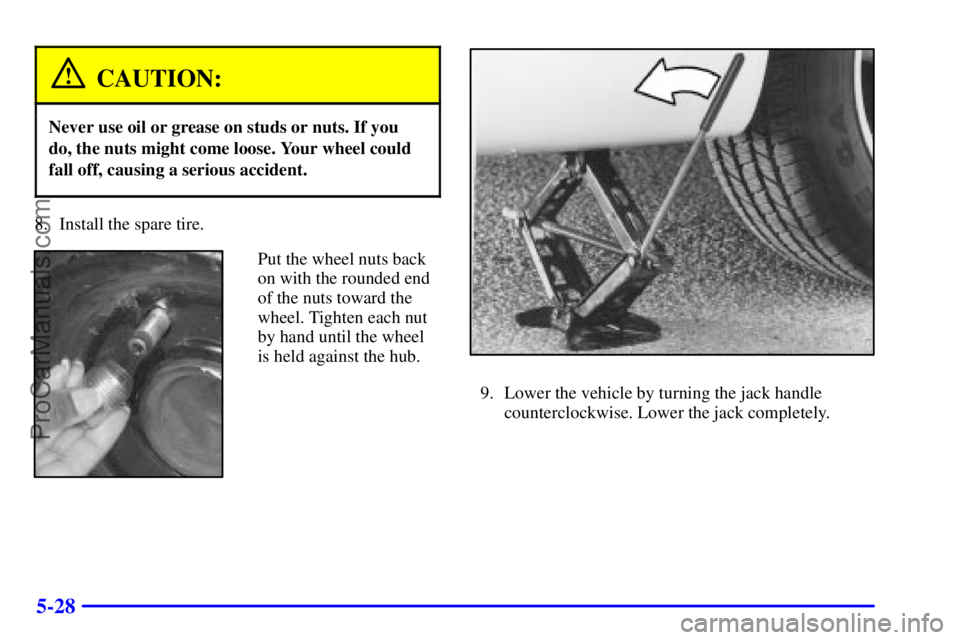
5-28
CAUTION:
Never use oil or grease on studs or nuts. If you
do, the nuts might come loose. Your wheel could
fall off, causing a serious accident.
8. Install the spare tire.
Put the wheel nuts back
on with the rounded end
of the nuts toward the
wheel. Tighten each nut
by hand until the wheel
is held against the hub.
9. Lower the vehicle by turning the jack handle
counterclockwise. Lower the jack completely.
ProCarManuals.com
Page 247 of 365
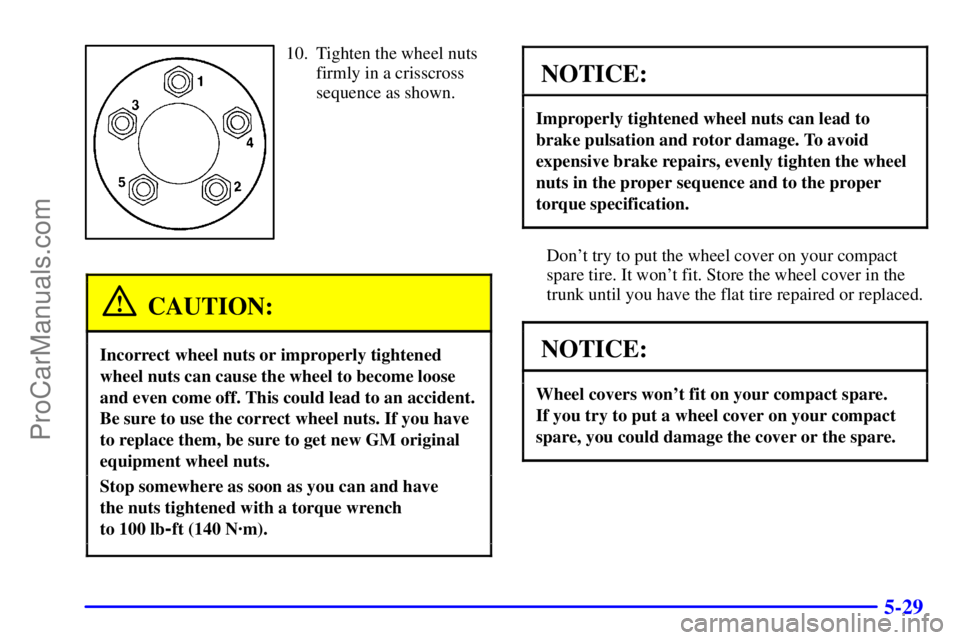
5-29
10. Tighten the wheel nuts
firmly in a crisscross
sequence as shown.
CAUTION:
Incorrect wheel nuts or improperly tightened
wheel nuts can cause the wheel to become loose
and even come off. This could lead to an accident.
Be sure to use the correct wheel nuts. If you have
to replace them, be sure to get new GM original
equipment wheel nuts.
Stop somewhere as soon as you can and have
the nuts tightened with a torque wrench
to 100 lb
-ft (140 N´m).
NOTICE:
Improperly tightened wheel nuts can lead to
brake pulsation and rotor damage. To avoid
expensive brake repairs, evenly tighten the wheel
nuts in the proper sequence and to the proper
torque specification.
Don't try to put the wheel cover on your compact
spare tire. It won't fit. Store the wheel cover in the
trunk until you have the flat tire repaired or replaced.
NOTICE:
Wheel covers won't fit on your compact spare.
If you try to put a wheel cover on your compact
spare, you could damage the cover or the spare.
ProCarManuals.com
Page 248 of 365
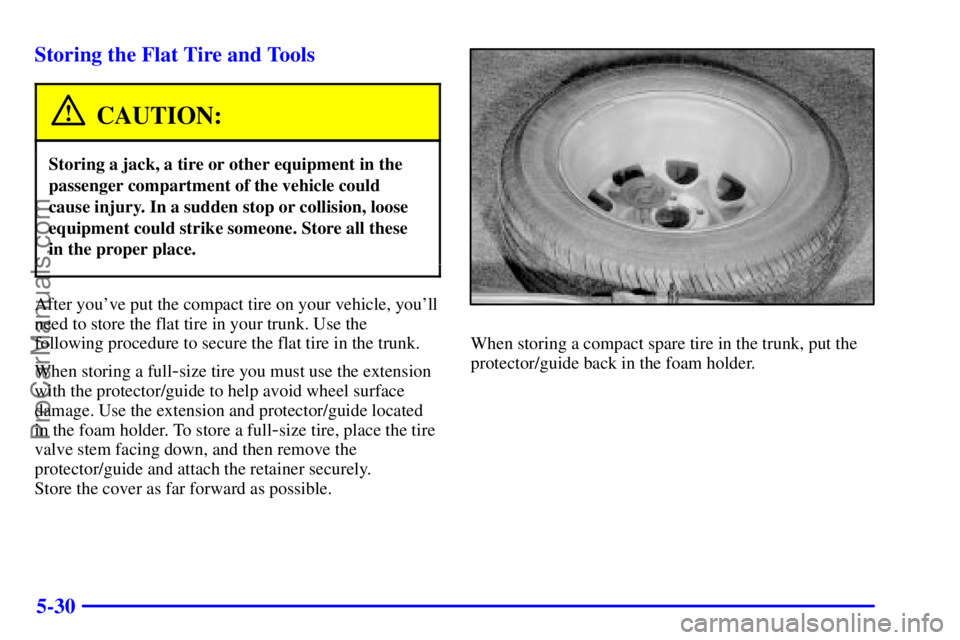
5-30 Storing the Flat Tire and Tools
CAUTION:
Storing a jack, a tire or other equipment in the
passenger compartment of the vehicle could
cause injury. In a sudden stop or collision, loose
equipment could strike someone. Store all these
in the proper place.
After you've put the compact tire on your vehicle, you'll
need to store the flat tire in your trunk. Use the
following procedure to secure the flat tire in the trunk.
When storing a full
-size tire you must use the extension
with the protector/guide to help avoid wheel surface
damage. Use the extension and protector/guide located
in the foam holder. To store a full
-size tire, place the tire
valve stem facing down, and then remove the
protector/guide and attach the retainer securely.
Store the cover as far forward as possible.
When storing a compact spare tire in the trunk, put the
protector/guide back in the foam holder.
ProCarManuals.com
Page 249 of 365
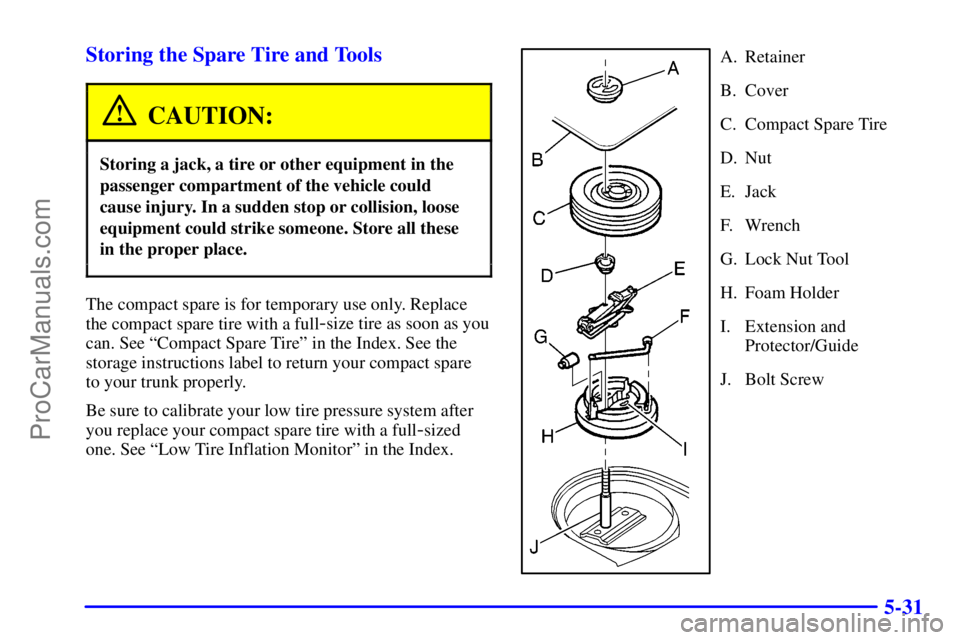
5-31 Storing the Spare Tire and Tools
CAUTION:
Storing a jack, a tire or other equipment in the
passenger compartment of the vehicle could
cause injury. In a sudden stop or collision, loose
equipment could strike someone. Store all these
in the proper place.
The compact spare is for temporary use only. Replace
the compact spare tire with a full
-size tire as soon as you
can. See ªCompact Spare Tireº in the Index. See the
storage instructions label to return your compact spare
to your trunk properly.
Be sure to calibrate your low tire pressure system after
you replace your compact spare tire with a full
-sized
one. See ªLow Tire Inflation Monitorº in the Index.
A. Retainer
B. Cover
C. Compact Spare Tire
D. Nut
E. Jack
F. Wrench
G. Lock Nut Tool
H. Foam Holder
I. Extension and
Protector/Guide
J. Bolt Screw
ProCarManuals.com
Page 250 of 365
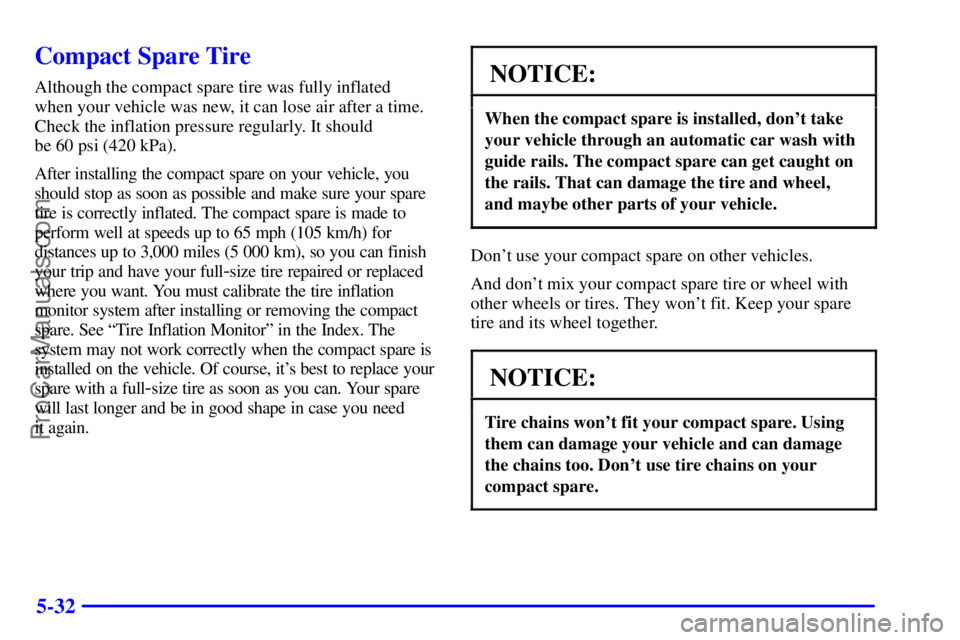
5-32
Compact Spare Tire
Although the compact spare tire was fully inflated
when your vehicle was new, it can lose air after a time.
Check the inflation pressure regularly. It should
be 60 psi (420 kPa).
After installing the compact spare on your vehicle, you
should stop as soon as possible and make sure your spare
tire is correctly inflated. The compact spare is made to
perform well at speeds up to 65 mph (105 km/h) for
distances up to 3,000 miles (5 000 km), so you can finish
your trip and have your full
-size tire repaired or replaced
where you want. You must calibrate the tire inflation
monitor system after installing or removing the compact
spare. See ªTire Inflation Monitorº in the Index. The
system may not work correctly when the compact spare is
installed on the vehicle. Of course, it's best to replace your
spare with a full
-size tire as soon as you can. Your spare
will last longer and be in good shape in case you need
it again.
NOTICE:
When the compact spare is installed, don't take
your vehicle through an automatic car wash with
guide rails. The compact spare can get caught on
the rails. That can damage the tire and wheel,
and maybe other parts of your vehicle.
Don't use your compact spare on other vehicles.
And don't mix your compact spare tire or wheel with
other wheels or tires. They won't fit. Keep your spare
tire and its wheel together.
NOTICE:
Tire chains won't fit your compact spare. Using
them can damage your vehicle and can damage
the chains too. Don't use tire chains on your
compact spare.
ProCarManuals.com